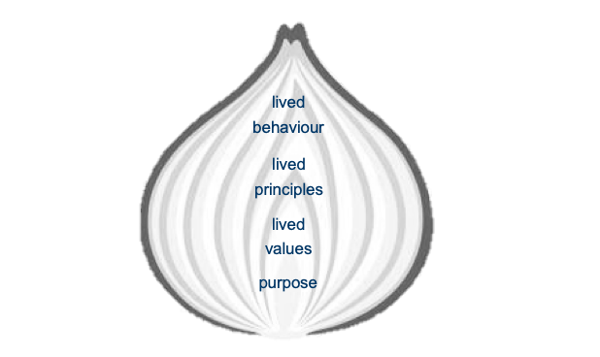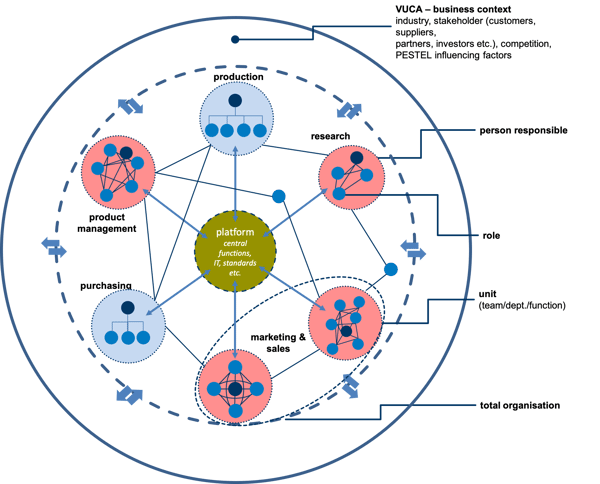Agile transformation (part 4) - designing a roadmap
In the course of an agile transformation, after the analysis of the status quo, it is necessary to communicate clearly what exactly one wants to achieve with the transformation. In the environment of VUCA and "permanent beta", goals can quickly disappear from sight because new challenges are constantly influencing day-to-day business.
A "roadmap" is a plan that defines a goal or a desired outcome and contains the most important steps and milestones required to achieve that goal.
But it also serves as a means of communication, a relatively high-level document that helps to formulate the strategic thinking - why - behind the goal and plan for achieving that goal.
Definition of the vision of the future
Even if you would like to publish a list of impressive "features", the overall picture should be considered as a desirable vision of the future.
Strategies form the bridge from the present to the future. Therefore, your "roadmap" should contain the procedure with which you would like to achieve your vision of the future.
In the next step you derive concrete goals for the decisive fields (productivity, finances, structures, culture ...). Don't expect your employees and colleagues to be convinced by your "roadmap" without defined goals.
Your "roadmap" should therefore always create a convincing connection between the desirable vision of the future, its inherent meaning ("purpose") and the strategies and goals derived from it. Especially for the employees during an agile transformation, transparency and clarity are decisive criteria that help to support the transformation.
Therefore: Define your vision of the future as clearly as possible and communicate it equally clearly.
Guidelines for the preparation of the roadmap
Why
In the first place it is important to deal with the "why". Clearly express the problem or opportunity you want the roadmap to solve. The answer to the "why" is the overarching meaning of the company.
Simon Sinek has written a nice book called "Start with Why", which deals with this procedure in detail. So when you create a "Roadmap", you need to be able to answer the "Why" precisely and precisely before taking the next steps. Many transformation projects often fail at the very beginning at this predetermined breaking point because there is no credible answer to the question of meaning. Why? Because the meaning of the company is often not even known. Only wanting to make "profit" or "more profit" is no longer a conclusive answer for most employees.
For example, ask: "Why does the organization have to go in this direction?" or "Why are these changes absolutely necessary?
What?
A logical roadmap makes clear what needs to be changed and how it should be done. What do we want to do?
The measures can be varied, and they in turn include the cornerstones defined in the strategy. If, for example, silos are to be broken up and cross-functional teams introduced, appropriate measures are needed to support this reorganization. Adapting the organizational chart is only the smallest step.
How
Many roads lead to Rome - describe the path that best suits your organisation, its culture, processes and values. The way is the goal at the same time. With HOW you show how serious you are about transformation. If a goal, for example, is that people should work together more and share their knowledge more, then this should also be reflected fundamentally in the way of transformation. If the working method is to become more "agile", then proceed consistently in iterative steps and visualize everything accordingly on Kanban or Scrum boards. And please not only on team level, but start with top management.
IT collaboration platforms should also provide technical support for transformation and agile working methods right from the start. This is where enormous efficiency gains lie dormant, with which you can relatively quickly convince even the rather sceptical colleagues of the change.
The same applies to the consistent use of retrospectives - perhaps the most valuable method ever. Regular retrospectives, in which you reflect on your cooperation, can be a great accelerator in terms of credibility, learning from experience and "making better".
Developing a community culture
A transformation leaves nothing as it was. Many things change and must also change in order to guarantee success. One aspect that is essential for the successful implementation of the roadmap in daily work and the pursuit of goals is a common culture that is the foundation of a transformation to a healthy organization.
The roadmap should also promote and demand a more developed culture within the organization. The onion principle is a good example as it shows that the individual shells are in harmony and grow from the inner core. The better the harmony, the more sense, values, lived principles and actually shown behaviour harmoniously merge into each other and thus form an organic unity of a transformed culture.

Figure 1: Onion model (own representation)
Creation of an ambiguous organisational design
In addition, it can be advantageous that "ambidextrous" action can be taken within the company and that both classical forms of organisation and adaptive forms of organisation in combination make it possible to overcome the challenges.
There are certainly business areas in which a classical, pyramidal organisation can be the right choice (production, finance ...). Other, more creative, more open areas (research, development, marketing ...) are enabled by adaptive structures to achieve success and diversity (see Figure 2). In agile transformation, the roadmap should consider precisely these points.
Which organizational design makes sense for the achievement of objectives? What changes do we have to make? What new structures need to be created?
Therefore, do not limit yourself mentally, but find the right operating system for the respective units in your organization. In the future, there will be numerous operating systems within an organization, as Figure 2 suggests. Therefore, do not clamp yourself to a system that is not adaptive and does not allow enough room for manoeuvre.

Figure 2: Kallenbach (p. 319, 2016)
Conclusion:
Creating a roadmap is an important aspect within an agile transformation. The focus on the future image and the necessary steps to achieve it are decisive. In this context, it is important to set up a flexible organizational design and an accompanying transformation of the corporate culture towards a common culture.
If you would like to find out more about "healthy organization", agility or our workshops, please feel free to inform yourself about our services in this area or simply contact us.
Outlook
In the fifth part of our series "Agile Transformation" you will learn how a transformation can start with a pilot project.
Further blog posts from the series "Agile transformation":
Agile transformation (part 1) - classic vs. agile
Agile transformation (part 2) - analysis of the status quo
Agile transformation (part 3) - three relevant premises
Agile transformation (part 5) - setting up a pilot project
Agile transformation (part 6) - methods and instruments
Agile transformation (part 7) - step on it!
Agile transformation (part 8) - questions and answers
Literature:
Kallenbach, Ingo (2016). Leadership in a Healthy Organization. Exceptional performance through potential development. Stuttgart: Schäffer-Poeschel.
Sinek, Simon (2011). Start with Why. How great leaders inspire everyone to take action. Penguin Books Ltd (UK).

